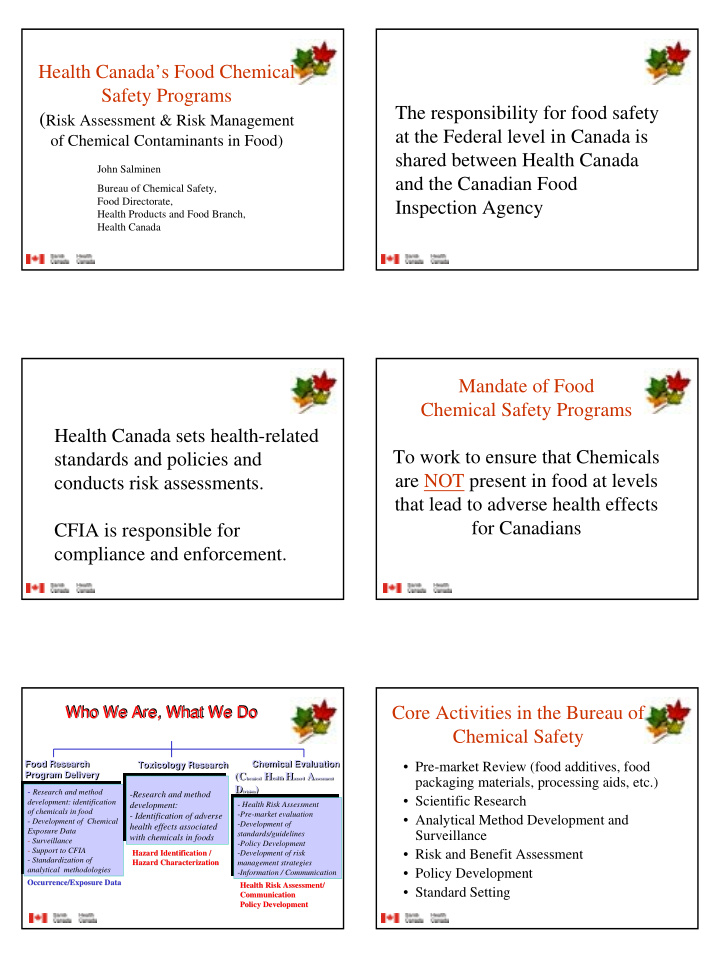



Health Canada’s Food Chemical Safety Programs The responsibility for food safety ( Risk Assessment & Risk Management at the Federal level in Canada is of Chemical Contaminants in Food) shared between Health Canada John Salminen and the Canadian Food Bureau of Chemical Safety, Food Directorate, Inspection Agency Health Products and Food Branch, Health Canada Mandate of Food Chemical Safety Programs Health Canada sets health-related To work to ensure that Chemicals standards and policies and are NOT present in food at levels conducts risk assessments. that lead to adverse health effects for Canadians CFIA is responsible for compliance and enforcement. Who We Are, What We Do Core Activities in the Bureau of Who We Are, What We Do Who We Are, What We Do Chemical Safety Food Research Food Research Chemical Evaluation Chemical Evaluation Toxicology Research Toxicology Research • Pre-market Review (food additives, food Program Delivery Program Delivery (C hemical H ealth H azard A ssessment (C hemical H ealth H azard A ssessment packaging materials, processing aids, etc.) D ivision ) - Research and method D ivision ) - Research and method - Research and method - Research and method • Scientific Research development: identification development: identification development: - Health Risk Assessment - Health Risk Assessment development: of chemicals in food of chemicals in food - Pre-market evaluation - Identification of adverse - Pre-market evaluation - Identification of adverse - Development of Chemical • Analytical Method Development and - Development of Chemical - Development of health effects associated - Development of health effects associated Exposure Data Exposure Data standards/guidelines standards/guidelines Surveillance with chemicals in foods with chemicals in foods - Surveillance - Surveillance - Policy Development - Policy Development - Support to CFIA - Support to CFIA - Development of risk • Risk and Benefit Assessment Hazard Identification / Hazard Identification / - Development of risk - Standardization of - Standardization of management strategies Hazard Characterization Hazard Characterization management strategies analytical methodologies analytical methodologies - Information / Communication • Policy Development - Information / Communication Occurrence/Exposure Data Occurrence/Exposure Data Health Risk Assessment/ Health Risk Assessment/ • Standard Setting Communication Communication Policy Development Policy Development
Chemicals That May Enter The Food Health Canada’s Decision Supply Making Framework • Food Additives (preservatives, flavours) Identify the Issue • Food Packaging Materials and its Context Pre-market • Agrochemicals (Pesticides and Veterinary Drugs) Monitor and Assess Risks PMRA-VDD Evaluate Results and Benefits Involve Interested • Natural Toxins (fungal, algal, microbial) and Post- Affected Parties market • “Processing-induced” chemicals Implement Identify and the Strategy Analyze Options ( Acrylamide, Furan, Chloropropanols, etc.) • Contaminants (metals, POPs, etc…) Select a Strategy Risk Management Priorities for Risk Management Options for Environmental Contaminants. Environmental Contaminants Reduce Exposure to: • Regulatory Tolerances in Specified Foods • Guidelines (e.g. action levels) • persistent organic pollutants (POPs) (such • Codes of Practice as Dioxins/Furans, PCBs, old pesticides); • Advice to Consumers • emerging contaminants (such as PBDEs, • Engagement of Food Producers and Food Industry PFCs, etc.); as part of HACCP plans • priority toxic elements (such as lead, • Regulation of Emissions to the Environment (e.g. elimination of specific point sources of methylmercury and cadmium); contamination) • “ionic toxicants” (such as perchlorate). • Multiple Strategies Lead in Food Methylmercury in Fish Risk Management Strategies Risk Management Strategies Currently in Use • Established Regulatory Tolerances and • Consumer Advisories Targeting Sensitive Guidelines Sub-Groups of the Population • Codes of Practice • Guidelines or Regulatory Tolerances • Changes to Food Production and Packaging • Reduction of Mercury Emissions to the Practices Environment • Reduction of Lead Emissions to the Environment • Consumer Advisories
DRIVERS FOR EFFECTIVE RISK MANAGEMENT • Based on sound science (research, surveillance / monitoring, risk assessment). RISK MANAGEMENT • Effective risk communication at every stage CHALLENGES of the decision-making process. • Multiple strategies. • Realistic and achievable. • Measurable outcomes. CHALLENGES CHALLENGES DIFFERENT RISK TO ENSURE THAT THE MANAGEMENT STRATEGIES SELECTED RISK MANAGEMENT FOR THE SAME CONTAMINANT STRATEGIES HAVE THE IN DIFFERENT COUNTRIES MAY INTENDED EFFECT AND DO CONFUSE CONSUMERS. NOT RESULT IN UNINTENDED NEGATIVE EFFECTS. CHALLENGES CHALLENGES PRIORITIES FOR RISK INCREASING CALLS TO MANAGEMENT BASED ON MEASURE OUTCOMES OR SCIENCE DO NOT ALWAYS PERFORMANCE OF SELECTED MATCH CONSUMER RISK MANAGEMENT PERCEPTIONS OF WHAT OUR STRATEGIES PRIORITIES SHOULD BE
These challenges illustrate the importance of • Ongoing research and surveillance • Accurate and timely risk assessments Thank -you ! • Well thought out risk management strategies Thank-you ! Thank-you ! • Clear and concise risk communication • Collaboration
Recommend
More recommend